Mulch is your friend, helping retain moisture and suppress weeds in the garden. See the many advantages—and disadvantages—to mulching. Plus, we list over 10 types of mulch—both organic and non-organic—and tips on how to mulch your garden, including amount of mulch needed.
WHAT IS MULCH?
At its simplest, mulch is a material that covers the soil for variety of reasons, usually controlling weeds.
ADVANTAGES OF MULCHING
Mulch has been called the gardener’s friend—and for good reason. It offers three major benefits:
- Reduces weed growth by keeping light from reaching the soil surface.
- Reduces water loss from the soil surface, which helps maintain soil moisture.
- Moderates of soil temperatures, keeping it warmer on cold nights and cooler on hot days
More Benefits of Mulching
There are many other benefits of mulch:
-
- In winter, soil under mulch will be warmer than unprotected soil. This protect plants from the cycle of freezing and thawing (which can heave them out of the ground).
- Reduces soil erosion and often reduces soil compaction.
- Prevents crusting of the soil surface. Water moves more readily into soil covered with mulch instead of running off.
- Keeps soil from splashing onto leaves; keeping soil off leaves reduces plant diseases.
- Breaks down and feeds the soil (if organic mulch).
- Improves the structure of clay soils and the moisture-holding capacity of sandy soils.
- Slowly increases soil fertility (if organic) and may make micronutrients already in the soil more available.
- Warm the soil in spring, allowing the gardener to plant days or weeks before the soil would normally be ready.
- Keeps plants clean and off the ground, especially tomatoes and melons, to avoid plant disease.
- Limits chance of hitting and damaging tree when mulch is placed around trees instead of grass (but not against bark).
- Improves plant health and growth (due to fewer weeds, more constant moisture and soil temperature).
- Makes gardens “spiffed up” and attractive, giving a uniform appearance and rhythm to garden design.
DISADVANTAGES OF MULCHING
Although using mulch has many benefits, it can also be detrimental to the garden:
-
- Over-mulching (more than 3 inches) can bury and suffocate plants; water and oxygen can’t reach the roots. A layer of 2 to 3 inches of mulch is ample.
- Mulch causes diseased trees if piled up around the trunks. Keep mulch 6 to 12 inches from the trunks of trees and shrubs. No more “volcano” mulching on trees! Keeping mulch away from the trunk prevents wood boring insects, gnawing rodents, and decay.
- Mulch near plant stems is the perfect place for slugs, snails, tunneling rodents, and more pests. Sprinkle wood ashes or diatomaceous earth around the base of precious plants to keep the slugs and snails at bay.
- Mulch can bake your plants with excess heat in midsummer if not done properly. (See more below.)
- Light colored, wood-based mulches, like sawdust or fresh wood chips, can steal nitrogen from the soil as they break down. Counter this effect by adding a nitrogen-rich fertilizer, such as soybean meal, alfalfa, or cottonseed meal, to the mulch. (Learn more about soil amendments.)
AMOUNT OF MULCH NEEDED
With most organic mulches, a layer of 2 to 3 inches is plenty. The finer the material, the thinner the layer needed.
Inorganic mulch is often more shallow; a mulch of small stones is usually an inch deep.
| If You Want Mulch This Deep… | …You Will Need This Mulch Mulch to Cover 100 Square Feet |
| 2 inches | 18 cubic feet |
| 3 inches | 27 cubic feet |
1 cubic yard = 27 cubic feet
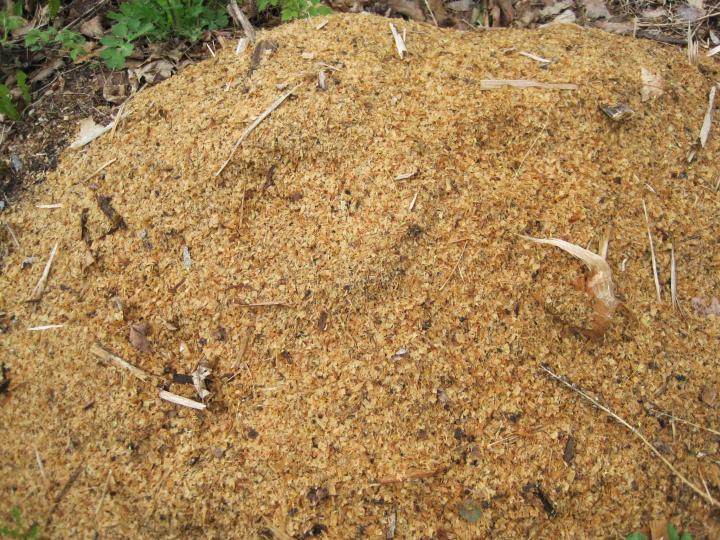
Dry mulches—including sawdust, woodchips, peat moss, and dry straw—can be a fire hazard. Keep them away from buildings to be on the safe side.
TYPES OF MULCH
The ideal mulch should be dense enough to block weed growth but light and open enough to allow water and air to reach the soil. Factors to consider when purchasing mulch are cost, availability, ease of application, and what it looks like in the garden. There are lots of materials of various colors and textures to choose from.
Both organic and inorganic mulches can be used effectively in the garden.
Organic Mulches
Organic mulches are natural products from leaves, trees, grass, and other plant material, often from your own yard. They mimic nature, breaking down gradually over time. The advantage is that they are truly adding organic matter to the soil. The disadvantage is that they must be replenished periodically.
-
- Compost is readily available and breaks down rapidly to improve soil. If you don’t have your own, often towns make it available from their leaf composting facility. The disadvantage is that it must be replenished and can contain weed seeds.
- Shredded or chipped bark. Softwood bark mulch is attractive, resists compaction, and breaks down slowly. Hardwood bark is attractive but breaks down quickly and needs to be properly composted to avoid sour mulch and nuisance fungi.
- Shredded leaves and leaf mold are readily available and, if chopped, eventually break down and feed the soil with beneficial materials. The disadvantage is that leaves can mat if wet which reduces the oxygen and moisture in the soil. Avoid matted layers of wet leaves.
- Straw and salt marsh hay are inexpensive and a helpful covering; however, they decompose more quickly, may harbor rodents, and are easily blown away by the wind.
- Grass clippings are ready available but should be dried first or spread thinly to keep them from becoming a hot, slimy, stinky mess. Also, you can not use clippings from grass treated with chemicals in a food garden.
- Pine needles are attractive and stay in place better than most mulches. They are slow to break down, so don’t worry about them adding to soil acidity.
- Local byproducts, such as spent hops from a brewery, cocoa hulls, ground corncobs, coffee grounds, newspaper, or cardboard can also be much. Get creative!
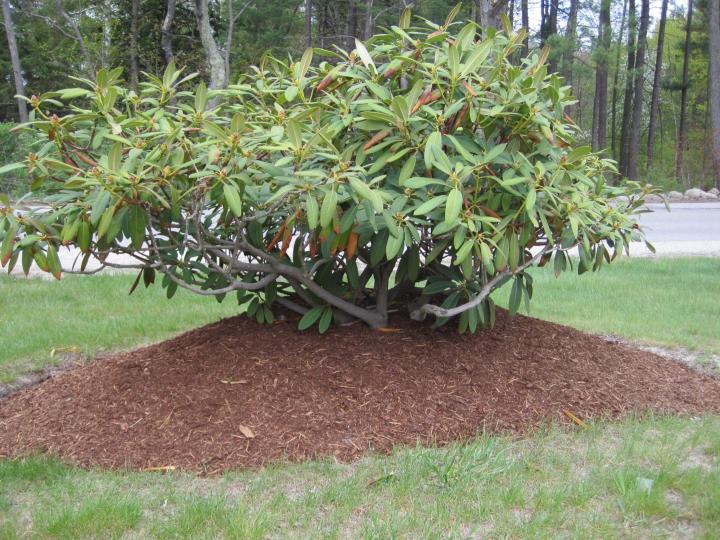
WARNING: Do not mulch like this! “Mulch volcanoes” will encourage rot at the base of the plant.
Inorganic Mulches
-
- Black plastic mulch helps warm the soil in spring, reduces water loss, and is convenient. This can make a big difference in short growing seasons. However, it’s not permeable so it’s more difficult to water; it also breaks down when exposed to sunlight and the soil under the plastic becomes very hot in the middle of summer if not shaded by leaves or covered with another mulch.
- Silver plastic mulch excels at warming soil in spring but doesn’t control weeds; the soil becomes even hotter with clear plastic in midsummer and plants can be damaged if the plastic is not shaded.
- Crushed stone, gravel, marble, or brick chips provide a permanent mulch around shrubs and trees. That said, these mulches are expensive, hard to move, and can get into the lawn. Weed seeds and soil can still find their way into the stones; an underlayer of landscape fabric will help prevent this.
- Landscape fabric smothers weeds while allowing air, fertilizer, and water to move through them and into the soil. They are treated to resist decomposition and they help retain soil moisture. It’s important to fasten the fabric down so perennial weeds do not push them up.
APPLYING MULCH
To cut down on weeding in our vegetable garden, we use a permeable landscape fabric on many of the beds.
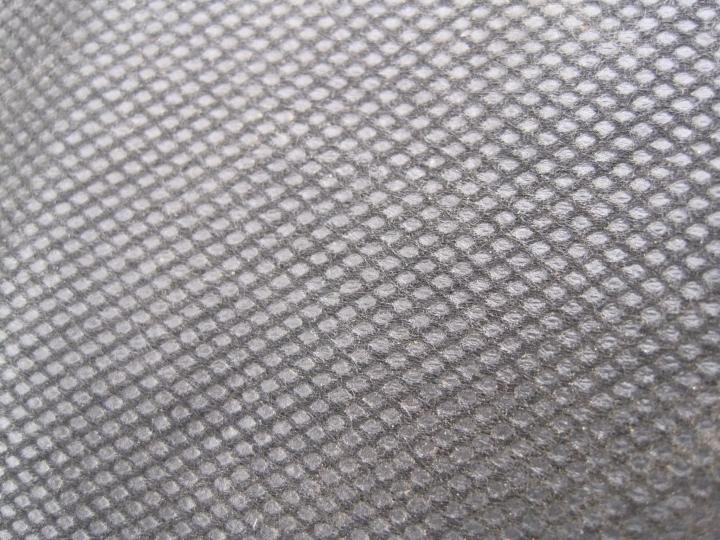
After a few spring rains, when the soil has warmed, we lay down soaker hoses in each bed.
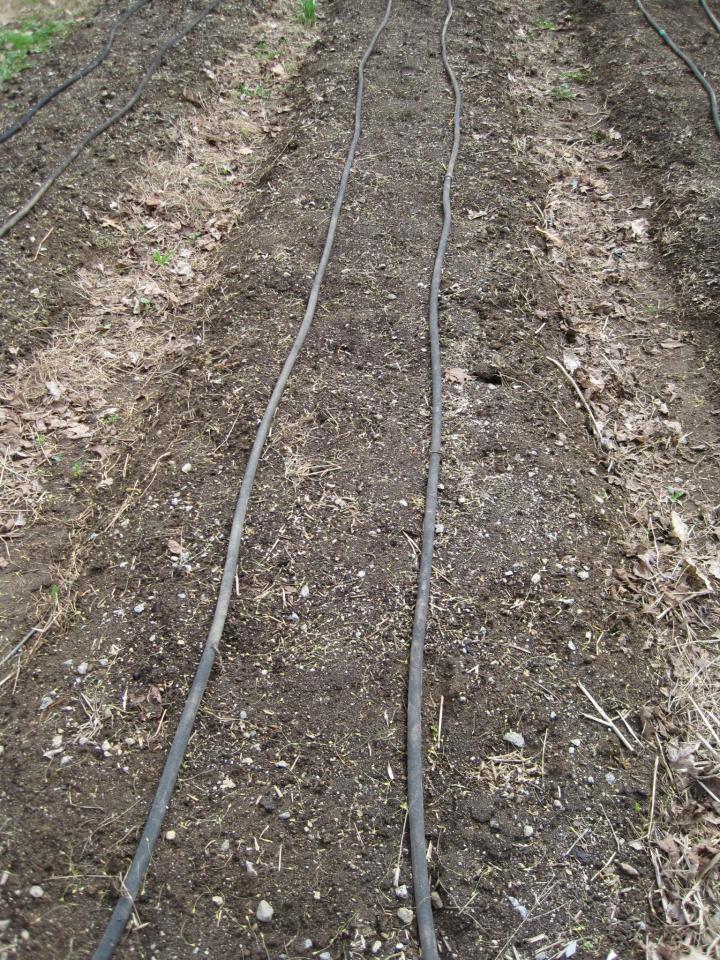
Then we cover the hoses with a fabric to speed up the change in soil temperatures and warm the soil for earlier planting.
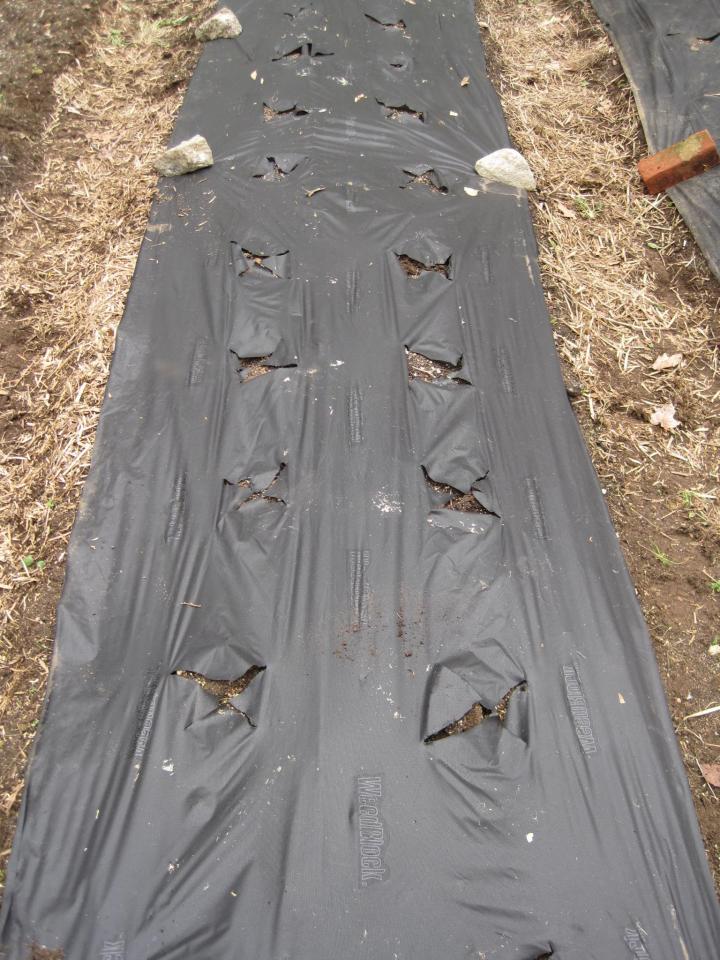
Planting holes are cut at different spacings for different crops. Watering is efficient, and maintenance of a large area is made much easier.
Once the plants get some size on them, the fabric is covered and does not look so bad! We also use straw, grass clippings, and shredded leaves for crops that like it cooler.
APPLYING MULCH IN FALL AND WINTER
Fall
If you need to replenish mulch, do finish by late summer or early autumn. Avoid applying mulch in mid- to late autumn. By then, the soil will not cool down quickly and plants may continue to grow. New growth may not harden off and can be damaged by winter cold. Also, mulch in the fall keeps the soil wet which can lead to root rot and plant death.
Winter
Once you’ve had several freezes and the soil has cooled (often Thanksgiving or after), then you can apply winter mulch to protect any tender plants or new plants that may not make it through the winter. Any plants correctly selected for hardiness do not need winter mulch. Winter mulch is deeper. Apply 3 to 4 inches. However, pull mulch away from the crown of plants and do not pile mulch against trunks of trees and shrubs. Loose mulch such as straw and evergreen boughs (from your Christmas tree, for example) is preferable because it does not retain excess moisture.
When spring begins, it’s important to reduce the winter mulch to a depth of 2 to 3 inches.
Follow the above advice and try mulching in your own garden!
Source / The Old Farmer’s Almanac

